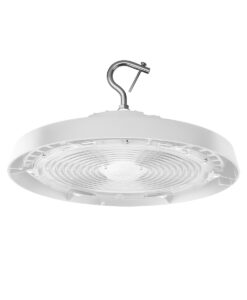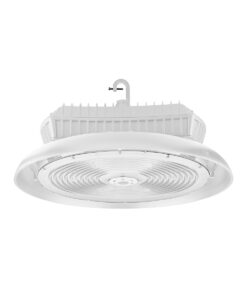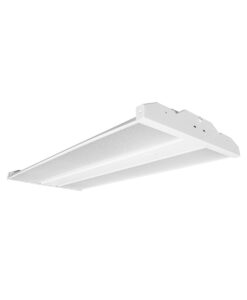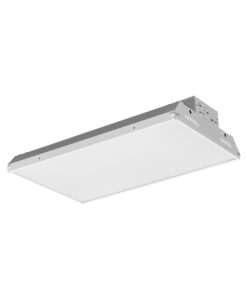Warehouse lighting plays a crucial role in the efficiency and safety of large-scale storage facilities. At PacLights, we understand the unique challenges of illuminating vast spaces effectively.
LED technology has revolutionized the way we light warehouses, offering unparalleled benefits in energy savings, visibility, and customization. In this post, we’ll explore how LED lighting solutions can transform your warehouse operations and boost productivity.
Why LED Warehouse Lighting Outshines Traditional Options
LED warehouse lighting has become the top choice for facility managers who want to maximize efficiency and safety. The advantages of LED technology in large-scale storage environments are substantial and measurable.
Slashing Energy Costs
LED lights are champions of energy efficiency. The U.S. Department of Energy reports that LEDs use up to 75% less energy than traditional lighting options. This translates to significant cost savings on electricity bills. A 100,000 square foot warehouse that switches from metal halide to LED high bay fixtures can save over $50,000 annually on energy costs alone.
Enhancing Visibility and Safety
Proper illumination is essential for workplace safety. LED lights provide consistent, bright light that reduces shadows and dark spots, which decreases the risk of accidents. The Illumination Engineering Society reports that high-quality LED lighting can improve visual acuity by up to 20% (allowing workers to better identify potential hazards and read labels accurately).
Minimizing Maintenance Headaches
The longevity of LED fixtures is unmatched. With lifespans ranging from 50,000 to 100,000 hours, LEDs outlast traditional bulbs by a factor of 2 to 5. This extended lifespan means fewer replacements and less downtime for maintenance. A study by McKinsey & Company found that warehouses using LED lighting typically see a 30% reduction in maintenance costs over five years.
Tailoring Light to Tasks
LED technology offers unprecedented control over lighting conditions. Color temperature can be adjusted from warm (3000K) to cool (6500K) to suit different areas and tasks. For instance, cooler temperatures in picking areas can increase alertness, while warmer tones in packing zones can reduce eye strain. Additionally, dimming capabilities allow for energy savings during low-activity periods or when natural light is available.
Customizing Solutions for Unique Spaces
Warehouse operators can create a more productive, safe, and energy-efficient workspace with a well-designed LED lighting system. High bays and linear strips can be customized to meet the unique needs of different areas within a facility. This flexibility allows for optimal illumination in various warehouse zones (such as storage racks, loading docks, and workstations).

The next chapter will explore how to choose the right LED fixtures for your specific warehouse needs, ensuring you maximize the benefits of this innovative lighting technology.
Selecting Optimal LED Fixtures for Warehouses
LED fixtures transform warehouse lighting, offering superior efficiency and safety. The selection process hinges on factors like ceiling height, aisle layout, and environmental conditions.
High Bay Lights: Illumination from Above
Warehouses with ceilings 20 feet or higher benefit from high bay LED lights. These fixtures provide broad, uniform illumination across large areas. The U.S. Department of Energy states that high bay LEDs can cut energy consumption by up to 60% compared to traditional metal halide fixtures.

Beam angle selection matters. Higher ceilings (30 feet) work well with narrow beam angles (60-90 degrees), while lower ceilings (20 feet) benefit from wider angles (120 degrees or more).
Linear Strip Lights: Aisle and Shelf Illumination
Narrower spaces like aisles and shelving areas require focused illumination from linear LED strip lights. These fixtures mount in continuous rows for even lighting along aisles. The Illuminating Engineering Society recommends 10 foot-candles (fc) for general warehouse lighting and up to 30 fc for detailed tasks.
Linear strips adapt easily to specific shelf heights and aisle widths. In an 8-foot wide aisle with 16-foot high shelving, two rows of linear strips at 14 feet provide optimal coverage.
Smart Lighting Controls: Efficiency Maximization
Smart controls enhance LED system efficiency significantly. Motion sensors reduce energy consumption by up to 30% in warehouses with variable occupancy patterns. These sensors activate lights only when needed (particularly useful in less frequented areas).
Daylight harvesting systems complement warehouses with skylights or large windows. These systems adjust artificial light based on available natural light, potentially saving 20-60% on lighting energy costs (according to the Lawrence Berkeley National Laboratory).
Environmental Considerations
Warehouse environments challenge lighting fixtures. Temperature fluctuations and humidity affect LED performance and lifespan. Fixtures with an IP65 rating or higher ensure dust and moisture resistance. Cold storage areas require LEDs designed for low temperatures, as standard LEDs may underperform in these conditions.
Loading docks and high-humidity areas benefit from vapor-tight LED fixtures. These sealed units prevent moisture ingress, ensuring consistent performance and longevity.
The right LED fixtures create a well-lit, energy-efficient environment that boosts productivity and safety. While quality LED fixtures require a higher initial investment, long-term energy savings and reduced maintenance costs justify the expense.
The next chapter will explore optimal lighting design strategies to maximize the benefits of your chosen LED fixtures and create an ideal warehouse illumination plan.
Designing Your Warehouse Lighting Plan
Calculating Fixture Quantity
The first step in creating an effective warehouse lighting plan involves determining the right number of fixtures. This calculation depends on factors such as space size, ceiling height, and required light levels. The Illuminating Engineering Society (IES) recommends 30 foot-candles for general warehouse areas and up to 50 foot-candles for detailed work areas.

To calculate the number of fixtures needed, divide the total required lumens by the lumens per fixture. For instance, a 100,000 square foot warehouse requiring 30 foot-candles (3,000 lumens per square meter) needs 27,870,912 total lumens. If each LED high bay fixture produces 30,000 lumens, you’ll need approximately 930 fixtures.
Optimizing Fixture Placement
Proper placement ensures even illumination throughout the warehouse. Avoid shadows or dark spots by spacing fixtures uniformly. A useful rule of thumb suggests spacing fixtures at 1 to 1.5 times the mounting height. In a warehouse with 30-foot ceilings, this translates to spacing fixtures every 30 to 45 feet.
Selecting Color Temperature and Rendering
Color temperature and color rendering index (CRI) significantly impact warehouse lighting effectiveness. Color temperature (measured in Kelvin) affects worker alertness and task performance. Most warehouses benefit from a color temperature between 4000K and 5000K, which provides a cool, crisp light that enhances visibility and reduces eye strain.
The CRI measures how accurately a light source renders colors compared to natural daylight. A higher CRI improves color differentiation (important for quality control and order picking). The U.S. Department of Energy recommends a CRI of at least 80 for most warehouse applications.
Tailoring Light for Specific Tasks
Different warehouse areas may require specialized lighting solutions. Loading docks need brighter illumination to ensure safety during vehicle operations. The Occupational Safety and Health Administration (OSHA) suggests a minimum of 10 foot-candles in outdoor loading areas and 20 foot-candles for indoor loading docks.
Areas with detailed work or quality control benefit from task lighting to supplement general illumination. LED task lights provide focused, high-intensity light without increasing overall energy consumption. These prove particularly useful in packing stations or areas where workers read small print on labels.
Implementing Smart Controls
Smart controls enhance LED system efficiency. Motion sensors reduce energy consumption by up to 30% in warehouses with variable occupancy patterns. These sensors activate lights only when needed (particularly useful in less frequented areas).
Daylight harvesting systems complement warehouses with skylights or large windows. These systems adjust artificial light based on available natural light. According to the Lawrence Berkeley National Laboratory, research on energy-efficient lighting systems is funded by the Office of Buildings and Community Systems, Assistant Secretary for Conservation and Solar Applications.
Final Thoughts
LED warehouse lighting has transformed large industrial spaces. It offers substantial energy savings, improved visibility, and reduced maintenance costs. Warehouse operators who implement LED technology create a more productive and safer work environment while cutting operational expenses.

The future of warehouse lighting technology promises even greater advancements. We expect further improvements in LED efficiency and more sophisticated smart lighting systems. These systems will offer enhanced integration with warehouse management tools and real-time adjustments based on occupancy and activity levels.
PacLights remains committed to offering cutting-edge LED solutions for warehouse operators. Our high-quality fixtures and advanced control systems help businesses achieve optimal illumination while minimizing energy consumption. As LED technology continues to shape the future of efficient industrial spaces, warehouse operators who embrace these advancements position themselves for long-term success.






Disclaimer: PacLights is not responsible for any actions taken based on the suggestions and information provided in this article, and readers should consult local building and electrical codes for proper guidance.